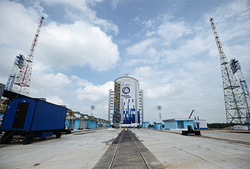 In Kolyma physicists test equipment for the Vostochny cosmodrome. Scientist, Institute of solar-terrestrial physics Nikolay Nevidimov testing the projectors on the masts of the Kolyma Observatory. Their capabilities will appreciate the scientific staff this winter. In Kolyma physicists test equipment for the Vostochny cosmodrome. Scientist, Institute of solar-terrestrial physics Nikolay Nevidimov testing the projectors on the masts of the Kolyma Observatory. Their capabilities will appreciate the scientific staff this winter.
On the basis of the Magadan Observatory installed 24 antenna, which will allow to study the ionosphere over the Arctic ocean. Until now, this huge area was not fully explored. The new equipment should help you to get unique information necessary for the operation of astronauts in earth orbit. For example, scientists can predict the behavior of cosmic storms, magnetic storms, ionospheric disturbances. Is directly dependent on the quality of radio and video communication with spacecraft.
The antenna field is part of the research complex "Super Gift." It is unparalleled in the world no more than ten. This antenna field is unique for Russia. It is built to meet the harsh Northern conditions. Will withstand strong winds and hard frosts. Antenna team of communication engineers from Irkutsk was established a few weeks. Secured their special cables are subject to strong winds, which in winter are common thing here. Until now, scientists of the Observatory in the village of Glass was engaged mainly in the study of the geomagnetic field. It is also an order of Astronautics. If you watch him from the Northern latitudes, solar flares look more pronounced. In addition, the Magadan area magnetic anomaly, and therefore scientific studies in this place are of particular value.
The signal from the antenna field will handle the equipment installed here. Any maintenance it requires. Ahead of his Internet connection and testing. In the near future the Observatory needs to lay optical fiber to supply high-speed Internet. Then start to check and adjust the equipment. At full capacity the research complex should earn in the next year.
sections: Society
|